
Applications
The physical and chemical properties of an ideal defoamer must meet the requirements of the application system. Generally speaking, the following requirements must be considered when choosing a defoamer:
(1) Strong defoaming ability, can effectively solve the foam when using a very small amount;
(2) Has a lower surface tension than the defoamed system;
(3) The addition of defoamer does not affect the basic performance of the defoamed system;
(4) is not soluble in the defoaming system, and is not easily solubilized by the surfactant in the system;
(5) The surface tension balance is better;
(6) does not react with the defoaming medium, nor will it be decomposed and degraded, and has good chemical stability;
(7) has good diffusibility and permeability, has a positive diffusion coefficient in the foam medium, and has a quick spreading ability on the foam surface;
(8) Good heat resistance and will not lose effectiveness at high temperatures;
(9) has good gas solubility and permeability;
(10) has high physiological activity in the defoaming system, and the defoaming agent itself is a low-toxic substance;
(11) has low chemical oxygen demand (COD), biochemical oxygen demand (BOD) and total oxygen demand (TOD);
(12) has good storage stability;
(13) It has a long-term defoaming effect, and some defoamers can quickly defoam, but they will become invalid after a long time;
(14) Low cost;
(15) does not increase the surface viscosity of the surfactant aqueous solution.
defoamers are difficult to meet the above requirements at the same time, and can only meet the requirements of the defoamed system in terms of main performance. Each defoamer can only be effective for a certain system or several systems, and a variety of different defoamers can be selected for the same foam system. Because of this, users should conduct experiments and choose economical defoamers .
-
 The research and application of mineral oils, amides, lowerraed moreAdvantages and disadvantages of different types of defoamers
The research and application of mineral oils, amides, lowerraed moreAdvantages and disadvantages of different types of defoamers -
 Soft finishing is an important finishing process in printingraed moreThe role of softener
Soft finishing is an important finishing process in printingraed moreThe role of softener -
 The application range of silicone oil is very common. It israed moreWhat are the application areas of silicone oil
The application range of silicone oil is very common. It israed moreWhat are the application areas of silicone oil
